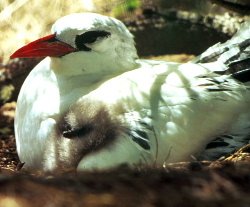Let's leave this discussion for
the moment and instead note that Kuukuu
had a 'tanist' (E:46):
"After they had departed from
Pu Pakakina they reached Vai
Marama and met a man. Ira asked,
'How many are you?' He answered, 'There were
two of us'.
Ira continued asking,
'Where is he (the other)?' To that he
answered, 'The one died'.
Again Ira asked, 'Who
has died?' He replied, 'That was Te Ohiro
A Te Runu'.
Ira asked anew, 'And who are
you?' He answered, 'Nga Tavake A Te Rona'."
The name of this man seems to
allude to Hua Tava, to the father of
Kuukuu.
|
Ga
Preposed plural marker of rare
usage. 1. Sometimes used with a few
nouns denoting human beings, more
often omitted. Te ga vţ'e, te ga
poki, the women and the
children. Ga rauhiva twins.
2. Used with some proper names.
Ga Vaka, Alpha and Beta Centauri
(lit. Canoes). Vanaga. |
|
Tava
Tavatava, pale.
Tavake,
sea bird, white, with rosy tail; its
feathers were used to decorate hats
and belts. Vanaga.
Mgv.: A shellfish.
To.:
tava-amanu, id.
Tavake, a seabird with a
long red tail. Mq.:
toavake,
toae,
the tropic bird. Sa.:
tava'e, id. Ta.:
Tavare, to trick, to
dupe. Mq.:
tavae, to cajole, to
flatter. Ma.:
taware,
to dupe, to fool.. Mq.:
Tavatava, a fish. Sa.:
tavatava, id. Ha.:
kawakawa, id. Churchill.
Tavari, the plant
Polygonum acuminatum
grows on the crater lakes in close
association with rushes and seems to
have been used for medicinal
purposes. Barthel 2. |
| Ke 1. Other; different; different being; hare kÚ, a different house; e-kÚ-ro-ß... e-kÚ-ro-ß... there are some who... and others who...; me'e kÚ, something distinct, different: te puaka ina oona kuhane; me'e kÚ te tagata, he hakari oona, he kuhane, an animal has no soul; man is different, he has a body, and a soul; matu'a kÚ, the other relatives. 2. KÚ te kairua, person who turns up for meals at other people's homes. 3. Used in exclamations: hahau kÚ! what a cool breeze!; hana kÚ! how hot! takeo kÚ! how cold! Vanaga.
Other, distinct, different, diverse, otherwise; koona ke, elsewhere; tagata ke, some one else; mea ke, contrary, distinct, otherwise; hakake, feint, stratagem, to feign; hagake, to act contrary. T Pau.: ke, different. Mgv.: ke, another, other, else, different, of partial comparative value. Mq.: ke, Ú, to be different, changed, no longer the same. Ta.: e, different, strange, other. Churchill. |
| Rona Figure made of wood, or stone, or painted, representing a bird, a birdman, a lizard, etc. Vanaga.
Drawing, traction. Pau.: ronarona, to pull one another about. Churchill.
While the rongorongo signs (rona) are generally 'carved out, incised' (motu), ta implies an incision ('cutting, beating') as well as the process of applying signs to the surface with the aid of a dye ... RAP. rona means primarily 'sign' (an individual sign in the Rongorongo script or a painted or carved sign made on a firm background, such as a petroglyph), but also 'sculpture' (made from wood or stone, representing animals of hybrid creatures) ... rona (lona) implies the idea of 'maintaining a straight line' with ropes and nets and also the maintaining of a steady course (in MAO. and TUA.).
Te Rona is the name of a star in TUA., which Makemson (1941:251) derives from the mythical figure of 'Rona', who is connected with the moon and is considered to be the father of (the moon goddess) Hina (for this role in MAO., see Tregear 1891:423).
From west Polynesia come totally different meanings. Interesting perhaps is FIJ. lona, 'to wonder what one is to eat, fasting for the dead.' ... Barthel 2 |
| Sons of Hau Maka |
Sons of Hua Tava |
| Ira |
Sun |
Kuukuu |
Mars |
Nga Tavake A Te Rona |
| Raparenga |
Moon |
Ringiringi |
Mercury |
Te Ohiro
A Te Runu |
| |
Nonoma |
Jupiter |
| Uure |
Venus |
| Makoi |
Saturn |
|
Runu To
take, to grab with the hand; to
receive, to welcome someone in one's
home. Ko Timoteo Pakarati
ku-runu-rivariva-ß ki a au i toona
hare, Timoteo Pakarati received
me well in his house. Runurunu,
iterative of runu: to take
continuously, to collect. Vanaga.
1. To pluck, to
pick, a burden. 2. A substitute;
runurunu, a representative.
Churchill. |
|
Hiro 1.
A deity invoked when praying for
rain (meaning uncertain). 2. To
twine tree fibres (hauhau, mahute)
into strings or ropes.
Ohirohiro,
waterspout
(more exactly p˙ ohirohiro),
a column of water which rises
spinning on itself.
Vanaga.
To spin, to twist.
P Mgv.: hiro, iro, to
make a cord or line in the native
manner by twisting on the thigh.
Mq.: fiˇ, hiˇ, to
spin, to twist, to twine. Ta.:
hiro, to twist. This differs
essentially from the in-and-out
movement involved in hiri 2,
for here the movement is that of
rolling on the axis of length, the
result is that of spinning. Starting
with the coir fiber, the first
operation is to roll (hiro)
by the palm of the hand upon the
thigh, which lies coveniently
exposed in the crosslegged sedentary
posture, two or three threads into a
cord; next to plait (hiri)
three or other odd number of such
cords into sennit. Hirohiro,
to mix, to blend, to dissolve, to
infuse, to inject, to season, to
streak with several colors;
hirohiro ei paatai, to salt.
Hirohiroa, to mingle;
hirohiroa ei vai, diluted with
water. Churchill.
Ta.: Hiro,
to exaggerate. Ha.: hilohilo,
to lengthen a speech by mentioning
little circumstances, to make nice
oratorial language. Churchill.
Whiro
'Steals-off-and-hides'; also [in
addition to the name of Mercury] the
universal name for the 'dark of the
Moon' or the first day of the lunar
month; also the deity of sneak
thieves and rascals.
Makemson. |
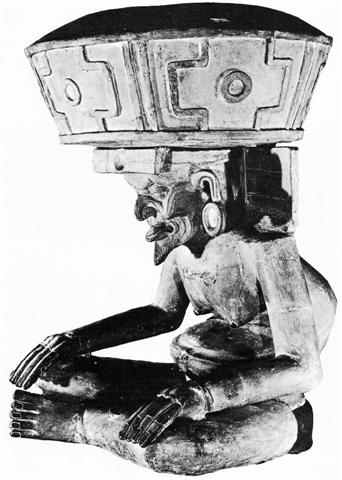
|
MAY 3 (*408) |
4 (*44) |
5 (125) |
6 |
7 |
|
"MARCH
3 |
4 (*348) |
5 (64 = 125
- 61) |
6 |
7 |
 |
 |
 |
 |
 |
|
Ga2-13 |
Ga2-14 |
Ga2-15 (45) |
Ga2-16 |
Ga2-17 |
|
WEZEN
(Weight)
= δ Canis
Majoris
(107.1), τ
Gemini
(107.7), δ
Monocerotis
(107.9) |
no star
listed (108) |
λ Gemini
(109.4),
WASAT
(Middle)
= δ Gemini
(109.8) |
no star
listed (110) |
ALUDRA
(Virgin,
singular)
= η Canis
Majoris
(111.1),
PROPUS = ι
Gemini
(111.4),
GOMEISA = β
Canis
Minoris
(111.6) |
|
July 6
(*107) |
7 (188) |
8 |
9 |
10 |
|
░July 2 |
3 (184) |
4 |
5 |
║July
6 (*107) |
|
'June 9 |
10 (161) |
11 |
12 |
13 (*84) |
|
"May 26 |
27 |
28 (148) |
29 |
30 (*70) |
|
MAY 8 |
9 |
10 (130) |
11 |
12 |
13 (*53) |
|
"MARCH 8 |
9 (68) |
10 |
11 |
12 |
13 |
 |
 |
 |
 |
 |
 |
|
Ga2-18 |
Ga2-19 |
Ga2-20 (50) |
Ga2-21 |
Ga2-22 |
Ga2-23 |
|
Ghost-23 (?)
ρ Gemini (?)
(112.1),
Eskimo Nebula =
NGC2392 Gemini
(112.2)
ANTARES (α
Scorpii)
|
Al Dhirā'-5 /
Punarvasu-7 /
Mash-mashu-Mahrū-10
(Western One
of the Twins)
CASTOR = α
Gemini
(113.4) |
ANA-TAHUA-VAHINE-O-TOA-TE-MANAVA-7
(Pillar for
elocution)
υ Gemini
(114.0),
MARKAB PUPPIS =
κ Puppis
(114.7), ο
Gemini (114.8),
PROCYON = α
Canis Minoris
(114.9) |
α Monocerotis
(115.4), σ
Gemini (115.7) |
Mash-mashu-arkū-11
(Eastern One
of the Twins)
κ Gemini
(116.1),
POLLUX = β
Gemini
(116.2), π
Gemini (116.9) |
AZMIDISKE = ξ
Puppis
(117.4) |
|
July 11 |
12 (193) |
13 |
14 (*115) |
15 |
16 |
|
░July 7 |
8 |
9 |
10 (*111) |
11 |
12 (193) |
|
'June 14 |
15 |
16 |
17 (168) |
18 |
19 (*90) |
|
"May 31 |
Maro 1 (*72) |
"June 2 |
3 |
4 |
5 (156) |
The Explorers departed from
Pu Pakakina in Hora Nui 1,
i.e. in September 1 when
plants under ground
should be planted and in
the day before
Hotu A Matua
departed from his old
homeland:
|
AUGUST 9 |
10 (222) |
11 |
12 |
13 (*145) |
|
"JUNE 9 (*80) |
10 (222 - 61 =
161) |
11 |
12 |
13 |
 |
 |
 |
 |
 |
|
Ga6-1 |
Ga6-2 |
Ga6-3 |
Ga6-4 (144) |
Ga6-5 (290 / 2) |
|
HEZE
= ζ Virginis
(205.0),
Southern
Pinwheel Galaxy
= M83 Hydrae
(205.7) |
ε Centauri
(206.3), κ Oct.
(206.4) |
no star listed
(207) |
τ Bootis
(208.2),
BENETNASH
= η Ursae
Majoris
(208.5), ν
Centauri
(208.7), μ
Centauri, υ
Bootis (208.8) |
no star listed
(209) |
|
October 12 (285) |
13 |
14 |
15 (*208) |
16 |
|
░October 8 |
9 |
10 |
11 (*204) |
12 (285) |
|
'September 15 |
16 |
17 (260) |
18 |
19 (*182) |
|
Hora Nui 1 (244) |
Hora Nui 2 |
"September 3 |
4 |
5 (*168) |
|
NAKSHATRA DATES: |
|
FEBRUARY 8
(*324) |
9 (40) |
10 |
11 |
12 (408) |
|
ACHERNAR
= α Eridani
(23.3), χ
Andromedae
(23.6), τ
Andromedae
(23.9) |
ALSEIPH
(Scimitar)
= φ Persei
(24.5), τ Ceti
(24.7) |
no star listed
(25) |
ANA-NIA-10
(Pillar-to-fish
by)
χ Ceti (26.1),
POLARIS
= α Ursae
Minoris, BATEN
KAITOS = ζ Ceti
(26.6),
METALLAH = α
Trianguli
(26.9) |
Al Sharatain-1 /
Ashvini-1 /
Bond-16 /
Mahrū-sha-rishu-ku-1
(Front of the
Head of Ku)
SEGIN = ε
Cassiopeia,
MESARTHIM = γ
Arietis, ψ
Phoenicis
(27.2),
SHERATAN
= β Arietis, φ
Phoenicis
(27.4) |
|
April 13 (468) |
4-14 (104) |
15 |
16 (471) |
17 (107) |
|
░April 9 |
10 (100) |
11 |
12 |
13 (*23) |
|
'March 17 |
18 (77) |
19 |
20 (*364) |
0h |
|
"March 3 |
4 (*348) |
5 (64) |
6 |
7 |
Counted from "June 13 (*84)
to "September 1 (*164) there were 80 days,
the same as from December 31 to March 21
(80).
... Hercules first appears in legend as a
pastoral sacred king and, perhaps because
shepherds welcome the birth of twin lambs,
is a twin himself. His characteristics and
history can be deduced from a mass of
legends, folk-customs and megalithic
monuments. He is the rain-maker of his tribe
and a sort of human thunder-storm. Legends
connect him with Libya and the Atlas
Mountains; he may well have originated
thereabouts in Palaeolithic times. The
priests of Egyptian Thebes, who called him
Shu
[Air], dated his origin as '17,000
years before the reign of King Amasis'.
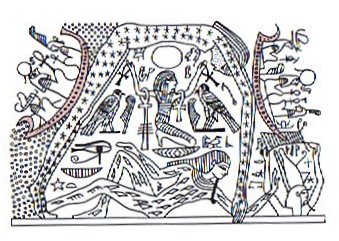 |
|
... Nut, whom the Greeks sometimes
identified with Rhea, was goddess of
the sky, but it was debatable if in
historical times she was the object
of a genuine cult. She was Geb's
twin sister and, it was said,
married him secretly and against the
will of Ra. Angered, Ra had the
couple brutally separated by Shu and
afterwards decreed that Nut could
not bear a child in any given month
of any year. Thoth, Plutarch tells
us, happily had pity on her. Playing
draughts with the Moon, he won in
the course of several games a
seventy-second part of the Moon's
light with which he composed five
new days. As these five intercalated
days did not belong to the official
Egyptian calendar of three hundred
and sixty days, Nut was thus able to
give birth successively to five
children: Osiris, Haroeris (Horus),
Set, Isis and Nepthys ... |
He carries an oak-club, because the oak
provides his beasts and his people with mast
and because it attracts lightning more than
any other tree. His symbols are the acorn;
the rock-dove, which nests in oaks as well
as in clefts of rocks; the mistletoe, or
Loranthus; and the serpent. All these
are sexual emblems. The dove was sacred to
the Love-goddess of Greece and Syria; the
serpent was the most ancient of phallic
totem-beasts; the cupped acorn stood for the
glans penis in both Greek and Latin;
the mistletoe was an all-heal and its names
viscus (Latin) and ixias
(Greek) are connected with vis and
ischus (strength) - probably because of
the spermal viscosity of its berries, sperm
being the vehicle of life.
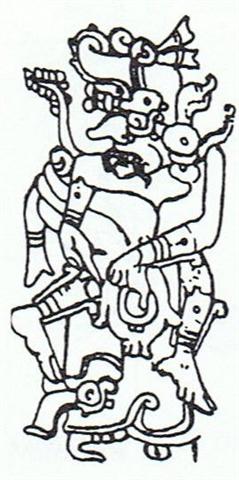
This Hercules is male leader of all
orgiastic rites and has twelve archer
companions, including his spear-armed twin,
who is his tanist or deputy. He
performs an annual green-wood marriage with
a queen of the woods, a sort of Maid Marian.
He is a mighty hunter and makes rain, when
it is needed, by rattling an oak-club
thunderously in a hollow oak and stirring a
pool with an oak branch - alternatively, by
rattling pebbles inside a sacred
colocinth-gourd or, later, by rolling black
meteoric stones inside a wooden chest - and
so attracting thunderstorms by sympathetic
magic.
The manner of his death can be reconstructed
from a variety of legends, folk-customs and
other religious survivals. At mid-summer, at
the end of a half-year reign, Hercules is
made drunk with mead and led into the middle
of a circle of twelve stones arranged around
an oak, in front of which stands an
altar-stone; the oak has been lopped until
it is T-shaped. He is bound to it with
willow thongs in the 'five-fold bond' which
joins wrists, neck, and ankles together,
beaten by his comrades till he faints, then
flayed, blinded, castrated, impaled with a
mistletoe stake, and finally hacked into
joints on the altar-stone.

His blood is
caught in a basin and used for sprinkling
the whole tribe to make them vigorous and
fruitful. The joints are roasted at twin
fires of oak-loppings, kindled with sacred
fire preserved from a lightning-blasted oak
or made by twirling an alder- or cornel-wood
fire-drill in an oak log. The trunk is then
uprooted and split into faggots which are
added to the flames. The twelve merry-men
rush in a wild figure-of-eight dance around
the fires, singing ecstatically and tearing
at the flesh with their teeth. The bloody
remains are burnt in the fire, all except
the genitals and the head. These are put
into an alder-wood boat and floated down the
river to an islet; though the head is
sometimes cured with smoke and preserved for
oracular use. His tanist succeeds him and
reigns for the remainder of the year, when
he is sacrificially killed by a new Hercules.
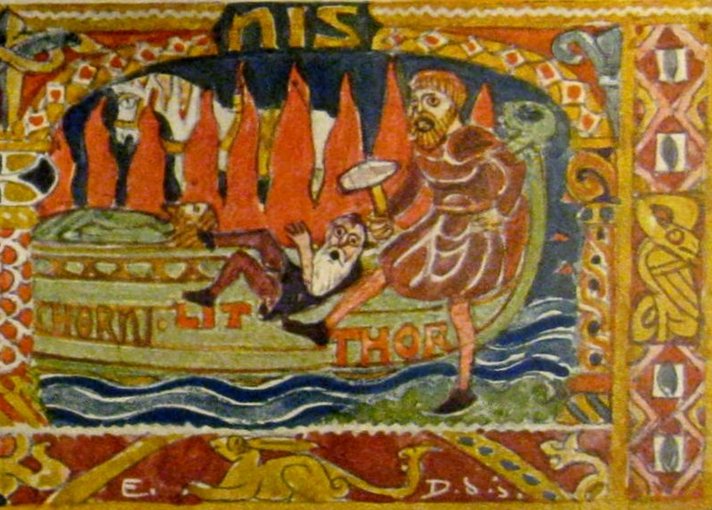
The divine names Bran, Saturn, Cronos ...
are applied to the ghost of Hercules that
floats off in the alder-wood boat after his
midsummer sacrifice. His tanist, or other
self, appearing in Greek legend as Poeas who
lighted Hercules' pyre and inherited his
arrows, succeeds him for the second half of
the year; having acquired royal virtue by
marriage with the queen, the representative
of the White Goddess, and by eating some
royal part of the dead man's body - heart,
shoulder or thigh-flesh.
He is in turn succeeded by the New Year
Hercules, a reincarnation of the murdered
man, who beheads him and, apparently, eats
his head. This alternate eucharistic
sacrifice made royalty continous, each king
in turn the Sun-god beloved of the reigning
Moon-goddess. But when these cannibalistic
rites were abandoned and the system was
gradually modified until a single king
reigned for a term of years,
Saturn-Cronos-Bran became a mere Old Year
ghost, permanently overthrown by
Juppiter-Zeus-Belin though yearly conjured
up for placation at the Saturnalia or Yule
feast ...
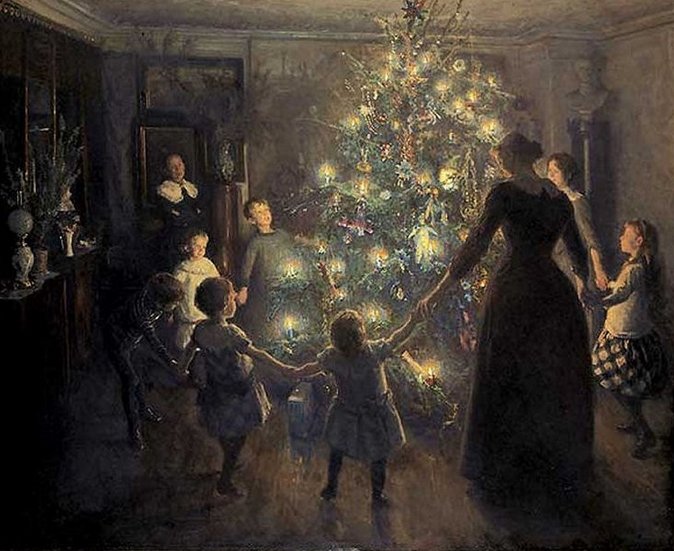
... The seventh tree is the oak, the tree of
Zeus, Juppiter, Hercules, The Dagda (the
chief of the elder Irish gods), Thor, and
all the other Thundergods, Jehovah in so far
as he was 'El', and Allah. The royalty of
the oak-tree needs no enlarging upon: most
people are familiar with the argument of Sir
James Frazer's Golden Bough, which
concerns the human sacrifice of the oak-king
of Nemi on Midsummer Day. The fuel of the
midsummer fires is always oak, the fire of
Vesta at Rome was fed with oak, and the
need-fire is always kindled in an oak-log.
When Gwion writes in the CÔd Goddeu,
'Stout Guardian of the door, His name in
every tongue', he is saying that doors are
customarily made of oak as the strongest and
toughest wood and that 'Duir', the
Beth-Luis-Nion name for 'Oak', means 'door'
in many European languages including Old
Goidelic dorus, Latin foris,
Greek thura, and German tŘr,
all derived from the Sanskrit Dwr,
and that Daleth, the Hebrew letter D,
means 'Door' - the 'l' being originally an
'r'.
Midsummer is the flowering season of the
oak, which is the tree of endurance and
triumph, and like the ash is said to 'court
the lightning flash'. Its roots are believed
to extend as deep underground as its
branches rise in the air - Virgil mentions
this - which makes it emblematic of a god
whose law runs both in Heaven and in the
Underworld ...

The month, which takes its
name from Juppiter the oak-god, begins on
June 10th and ends of July 7th. Midway comes
St. John's Day, June 24th, the day on which
the oak-king was sacrificially burned alive.
The Celtic year was divided into two halves
with the second half beginning in July,
apparently after a seven-day wake, or
funeral feast, in the oak-king's honour ...
The dates
given here (in Manuscript E) are probably referring to Roman
times, where 'June 10 coincided with Ga2-14
(we can see above) and 'July 7 with heliacal
Acubens. Possibly vaha mea in Ga3-13
can be understood as a referens to Roman
times:
|
MAY 25 (290 / 2) |
26 (*66) |
27 |
28 |
|
"MARCH 25 (84) |
26 (*5 = *66 - 61) |
27 |
28 |
 |
 |
 |
 |
|
Ga3-6 |
Ga3-7 |
Ga3-8 |
Ga3-9 (68) |
|
Āshleshā-9 /
Willow-24
π╣ Ursa
Majoris,
δ Hydrae (129.6),
AL MINHAR AL SHUJĀ
= σ Hydrae,
MUSEIDA
= π▓ Ursae Majoris
(129.9)
RAS ALHAGUE (α Ophiuchi)
|
Al Nathrah-6
BEEHIVE
= ε
Cancri,
η Pyxidis
(130.4), XESTUS
= ο Velorum
(130.5),
ζ Pyxidis
(130.7),
ASCELLUS BOREALIS
= γ Cancri,
β Pyxidis
(130.9) |
Extended Net-26a /
Arkū-sha-nangaru-sha-shūtu-12
(Southeast
Star in the Crab)
η Hydrae
(131.0),
ASCELLUS
AUSTRALIS = δ
Cancri
(131.4),
KOO SHE (Bow and Arrow) = δ Velorum
(131.6),
α Pyxidis
(131.8),
ε Hydrae
(131.9) |
ι Cancri
(132.0),
ρ Hydrae
(132.4) |
|
July 28 |
29 (*130) |
30 |
31 (212) |
|
░July 24 |
25 |
26 (*127) |
27 (208) |
|
'July 1 |
2 |
3 (*104) |
4 (185) |
|
"June 17 |
18 |
19 (*90) |
20 (171) |
|
MAY 29 |
30 |
31 (151) |
JUNE 1 |
2 (*73) |
3 |
4 |
|
"MARCH 29 |
30 |
31 (90) |
"APRIL 1 |
2 (*12) |
3 |
4 |
 |
 |
 |
 |
 |
 |
 |
|
Ga3-10 |
Ga3-11 |
Ga3-12 |
Ga3-13 (72) |
Ga3-14 |
Ga3-15 |
Ga3-16 |
|
γ
Pyxidis
(133.6) |
ζ Hydrae
(134.1), ρ Cancri (134.2), ζ Oct. (134.3), ο Cancri (134.6),
δ
Pyxidis
(134.9) |
ACUBENS = α Cancri, TALITHA
BOREALIS = ι Ursae Majoris
(135.0),
σ Cancri (135.2), ρ Ursa Majoris (135.6) |
ν Cancri (136.0),
TALITHA AUSTRALIS
= κ Ursae Majoris
(136.1), ω Hydrae (136.8) |
9h (137.0)
σ╣ Ursa Majoris (137.0), κ
Cancri (137.3), τ Cancri (137.4),
ALSUHAIL
= λ Velorum
(137.5), σ▓ Ursa Majoris (137.6), τ Ursa Majoris (137.7),
ξ Cancri
(137.8) |
κ
Pyxidis
(138.0),
ε Pyxidis
(138.5) |
π Cancri (139.2),
MIAPLACIDUS = β Carinae
(139.3),
TUREIS = ι Carinae
(139.8) |
|
August 1 |
2 |
3 (*500) |
4 (216) |
5 |
6 |
7 |
|
░July 28 |
29 (*130) |
30 |
31 |
░August 1 |
2 (214) |
3 |
|
'July 5 |
6 (*107) |
7 |
8 |
9 (190) |
10 |
11 |
|
SOLSTICE |
"June 22 (*93) |
23 |
ST JOHN'S DAY |
25 |
26 (177) |
27 |
Between
Maro 15 and Anakena 5
(at Ga2-28 respectively Ga3-24) there are
no dates given in Manuscript E.
 |
40 |
 |
67 |
 |
72 |
 |
|
Gb7-25
(435) |
Ga1-4
(ALDEBARAN) |
Ga3-13 |
Ga6-5 (290 / 2) |
|
SHERATAN |
41 (BHARANI, 41 Arietis) |
141 |
|
FEBR 12 (408) |
182 (= 10 * 59 - 408) |

|
